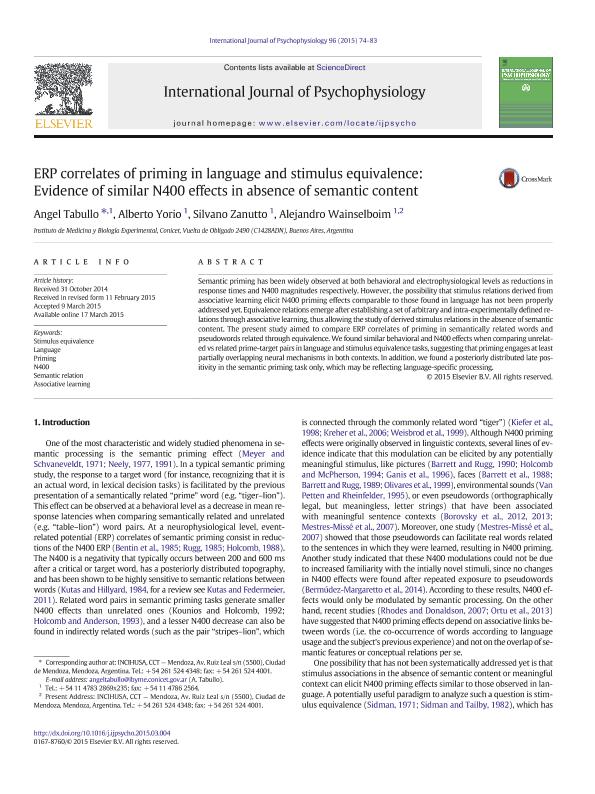Mostrar el registro sencillo del ítem
dc.contributor.author
Tabullo, Angel Javier

dc.contributor.author
Yorio, Alberto

dc.contributor.author
Zanutto, Bonifacio Silvano

dc.contributor.author
Wainselboim, Alejandro Javier

dc.date.available
2018-09-07T13:58:01Z
dc.date.issued
2015-05
dc.identifier.citation
Tabullo, Angel Javier; Yorio, Alberto; Zanutto, Bonifacio Silvano; Wainselboim, Alejandro Javier; ERP correlates of priming in language and stimulus equivalence: Evidence of similar N400 effects in absence of semantic content; Elsevier Science; International Journal Of Psychophysiology; 96; 2; 5-2015; 74-83
dc.identifier.issn
0167-8760
dc.identifier.uri
http://hdl.handle.net/11336/58675
dc.description.abstract
Semantic priming has been widely observed at both behavioral and electrophysiological levels as reductions in response times and N400 magnitudes respectively. However, the possibility that stimulus relations derived from associative learning elicit N400 priming effects comparable to those found in language has not been properly addressed yet. Equivalence relations emerge after establishing a set of arbitrary and intra-experimentally defined relations through associative learning, thus allowing the study of derived stimulus relations in the absence of semantic content. The present study aimed to compare ERP correlates of priming in semantically related words and pseudowords related through equivalence. We found similar behavioral and N400 effects when comparing unrelated vs related prime-target pairs in language and stimulus equivalence tasks, suggesting that priming engages at least partially overlapping neural mechanisms in both contexts. In addition, we found a posteriorly distributed late positivity in the semantic priming task only, which may be reflecting language-specific processing.
dc.format
application/pdf
dc.language.iso
eng
dc.publisher
Elsevier Science

dc.rights
info:eu-repo/semantics/openAccess
dc.rights.uri
https://creativecommons.org/licenses/by-nc-sa/2.5/ar/
dc.subject
Associative Learning
dc.subject
Language
dc.subject
N400
dc.subject
Priming
dc.subject
Semantic Relation
dc.subject
Stimulus Equivalence
dc.subject.classification
Psicología

dc.subject.classification
Psicología

dc.subject.classification
CIENCIAS SOCIALES

dc.title
ERP correlates of priming in language and stimulus equivalence: Evidence of similar N400 effects in absence of semantic content
dc.type
info:eu-repo/semantics/article
dc.type
info:ar-repo/semantics/artículo
dc.type
info:eu-repo/semantics/publishedVersion
dc.date.updated
2018-09-04T18:47:50Z
dc.journal.volume
96
dc.journal.number
2
dc.journal.pagination
74-83
dc.journal.pais
Países Bajos

dc.journal.ciudad
Amsterdam
dc.description.fil
Fil: Tabullo, Angel Javier. Consejo Nacional de Investigaciones Científicas y Técnicas. Instituto de Biología y Medicina Experimental. Fundación de Instituto de Biología y Medicina Experimental. Instituto de Biología y Medicina Experimental; Argentina
dc.description.fil
Fil: Yorio, Alberto. Consejo Nacional de Investigaciones Científicas y Técnicas. Instituto de Biología y Medicina Experimental. Fundación de Instituto de Biología y Medicina Experimental. Instituto de Biología y Medicina Experimental; Argentina
dc.description.fil
Fil: Zanutto, Bonifacio Silvano. Consejo Nacional de Investigaciones Científicas y Técnicas. Instituto de Biología y Medicina Experimental. Fundación de Instituto de Biología y Medicina Experimental. Instituto de Biología y Medicina Experimental; Argentina
dc.description.fil
Fil: Wainselboim, Alejandro Javier. Consejo Nacional de Investigaciones Científicas y Técnicas. Instituto de Biología y Medicina Experimental. Fundación de Instituto de Biología y Medicina Experimental. Instituto de Biología y Medicina Experimental; Argentina
dc.journal.title
International Journal Of Psychophysiology

dc.relation.alternativeid
info:eu-repo/semantics/altIdentifier/doi/https://dx.doi.org/10.1016/j.ijpsycho.2015.03.004
dc.relation.alternativeid
info:eu-repo/semantics/altIdentifier/url/https://www.sciencedirect.com/science/article/pii/S0167876015001117
Archivos asociados
